Camping in Sardinia offers breathtaking natural beauty and diverse amenities at sites like Cala Gonone, Costa Rei, and La Maddalena. Understanding local regulations is crucial for environmental protection and safety. Awareness of the potential environmental impact of camping activities helps ensure sustainable practices. Planning for weather conditions and campsite availability enhances the overall experience.
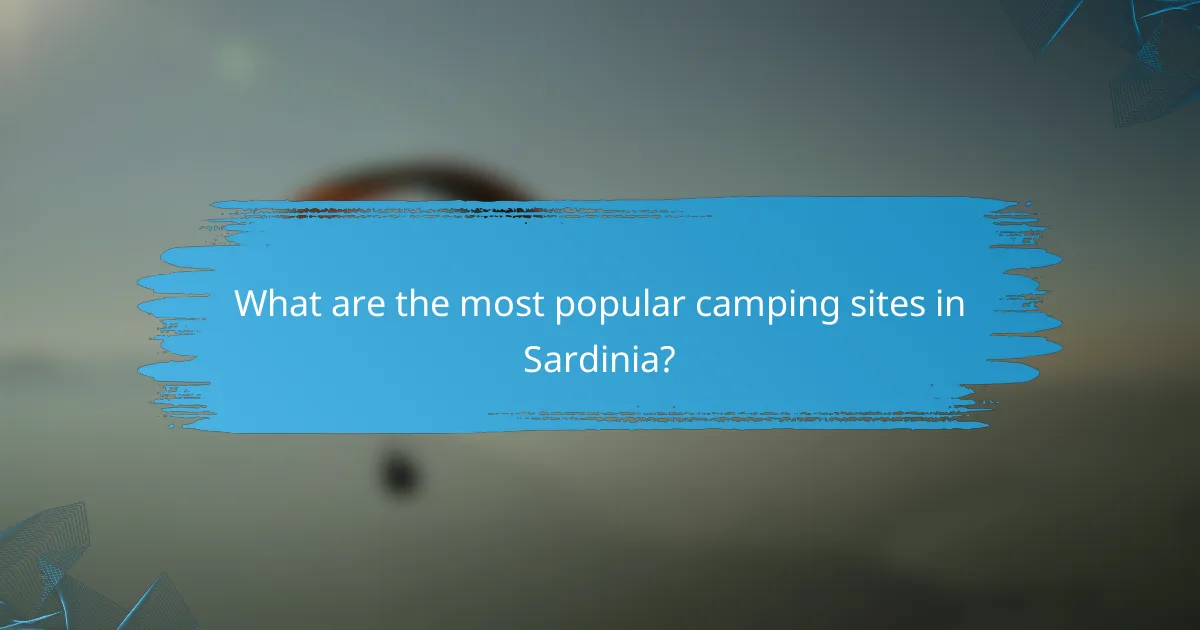
What are the most popular camping sites in Sardinia?
The most popular camping sites in Sardinia include Cala Gonone, Costa Rei, and La Maddalena. These locations offer stunning natural beauty and diverse amenities. Cala Gonone features breathtaking coastal views and access to hiking trails. Costa Rei is known for its long sandy beaches and family-friendly atmosphere. La Maddalena provides unique island camping experiences with crystal-clear waters. Each site showcases Sardinia’s rich natural environment and outdoor recreational opportunities.
Which regions offer the best camping experiences?
Sardinia offers some of the best camping experiences with diverse landscapes and well-regulated sites. The island features coastal campsites, mountainous areas, and nature reserves. Popular camping locations include the Gulf of Orosei, La Maddalena Archipelago, and Gennargentu National Park. Regulations ensure environmental protection and promote sustainable practices. Campers can enjoy stunning views, hiking trails, and unique flora and fauna.
What unique features do specific sites provide?
Camping sites in Sardinia offer unique features such as stunning coastal views, diverse ecosystems, and eco-friendly accommodations. Many sites are situated near pristine beaches, providing easy access to water activities. Regulations often emphasize sustainability, with guidelines to minimize environmental impact. Certain locations, like the Gennargentu National Park, feature unique wildlife and hiking trails, enhancing the camping experience. Additionally, some sites provide amenities like communal kitchens and organized activities, fostering a sense of community among campers.
How do user reviews influence site selection?
User reviews significantly impact site selection for camping in Sardinia by providing firsthand insights. They influence potential campers’ decisions through shared experiences and ratings. Positive reviews often highlight unique attributes, such as scenic views or amenities, while negative feedback can deter visitors. Additionally, reviews can inform users about regulations and environmental impacts, guiding responsible camping choices. Overall, user reviews serve as a crucial resource for evaluating camping sites effectively.
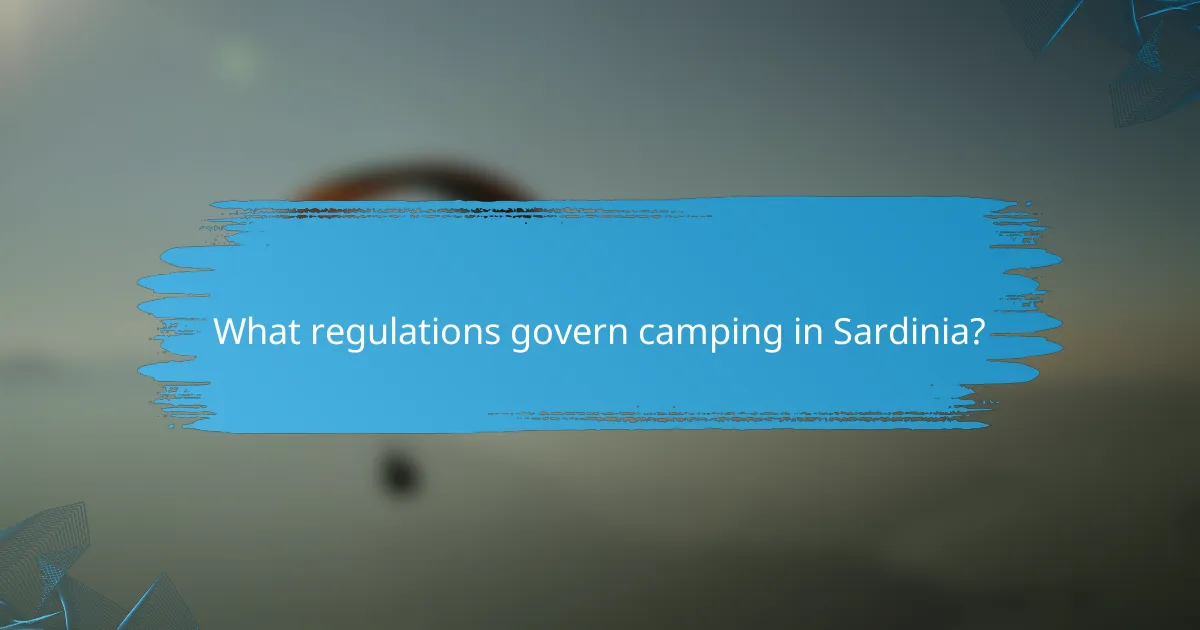
What regulations govern camping in Sardinia?
Camping in Sardinia is governed by specific regulations that prioritize environmental protection and safety. These regulations include restrictions on campfire use, waste disposal, and camping locations to preserve natural habitats. Campers must obtain permits for designated areas, ensuring compliance with local laws. Additionally, respecting wildlife and adhering to noise limits are crucial for a sustainable camping experience.
Which permits are required for camping activities?
Camping in Sardinia generally requires specific permits depending on the location and type of camping. Most campsites need a permit for overnight stays, while wild camping often requires approval from local authorities. Always check regional regulations for compliance.
What are the rules regarding campfires and waste disposal?
Campfires are generally prohibited in Sardinia due to fire risk. Waste disposal regulations require campers to carry out all trash, ensuring environmental protection. Local guidelines may vary, so always check site-specific rules before camping.
How do regulations differ across various regions?
Regulations for camping in Sardinia vary significantly by region. Coastal areas often have stricter rules to protect natural habitats, while inland sites may allow more flexibility. Sardinia’s regional authorities enforce regulations related to campsite operations, environmental conservation, and waste management. For example, some regions require permits for campfires, while others prohibit them entirely. Understanding these differences is crucial for campers to ensure compliance and minimize environmental impact.
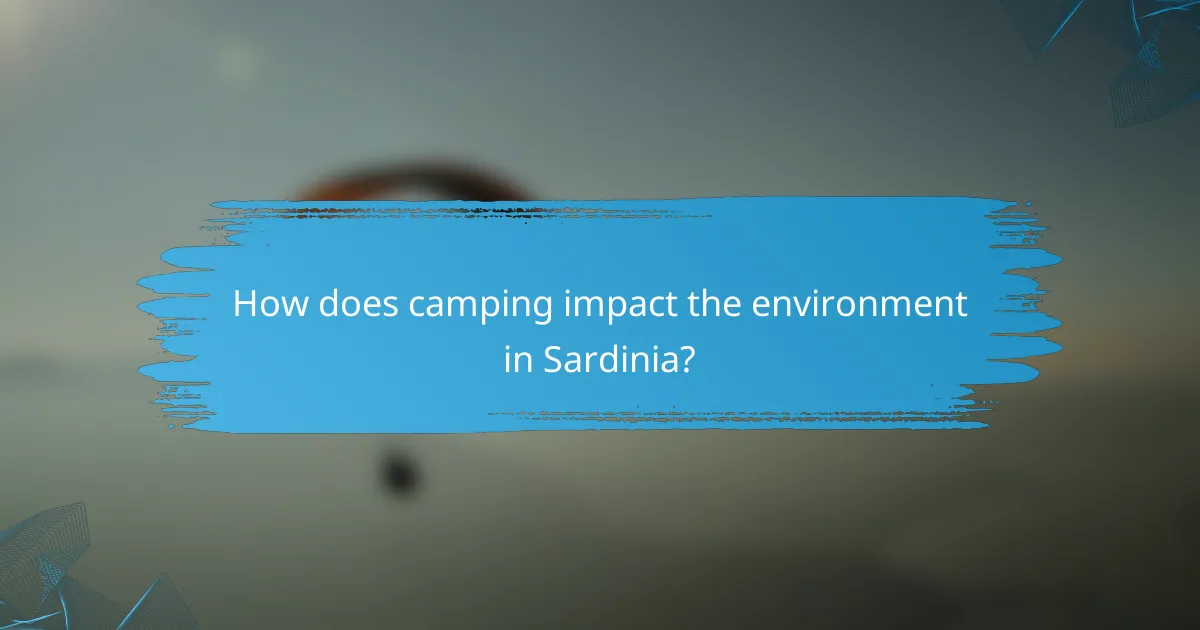
How does camping impact the environment in Sardinia?
Camping in Sardinia can negatively impact the environment through habitat disruption, waste generation, and resource depletion. Campsites often disturb local flora and fauna, leading to ecosystem imbalance. Proper regulations are essential to mitigate these effects. For instance, designated camping areas help minimize ecological footprints. Additionally, educating campers on Leave No Trace principles can further protect Sardinia’s natural beauty.
What are the ecological effects of camping on local wildlife?
Camping can negatively impact local wildlife by disrupting habitats and altering animal behavior. Disturbances from noise, waste, and human presence can lead to stress in animals and reduced reproduction rates. For instance, frequent camping in Sardinia’s natural reserves can displace species like the Sardinian deer, affecting their feeding and breeding patterns. As a result, maintaining designated camping areas and following regulations is crucial to mitigate these ecological effects.
How can campers minimize their environmental footprint?
Campers can minimize their environmental footprint by following sustainable practices. Choosing established campsites reduces habitat disruption. Using biodegradable products limits pollution. Proper waste disposal prevents littering and protects local wildlife. Opting for low-impact gear, like lightweight tents, reduces resource consumption. Additionally, practicing Leave No Trace principles ensures minimal impact on natural surroundings.
What initiatives exist to promote sustainable camping practices?
Various initiatives promote sustainable camping practices in Sardinia, focusing on environmental conservation and responsible tourism. These include educational programs, campsite regulations, and community engagement efforts.
Educational programs teach campers about local ecosystems and sustainable practices. Campsites often implement regulations, such as waste management systems and restrictions on fire usage, to minimize environmental impact. Community engagement encourages collaboration between campers and local residents to preserve natural resources.
Additionally, organizations promote eco-friendly camping gear and practices, enhancing the overall sustainability of camping experiences. These initiatives collectively aim to protect Sardinia’s unique landscapes while providing enjoyable camping opportunities.
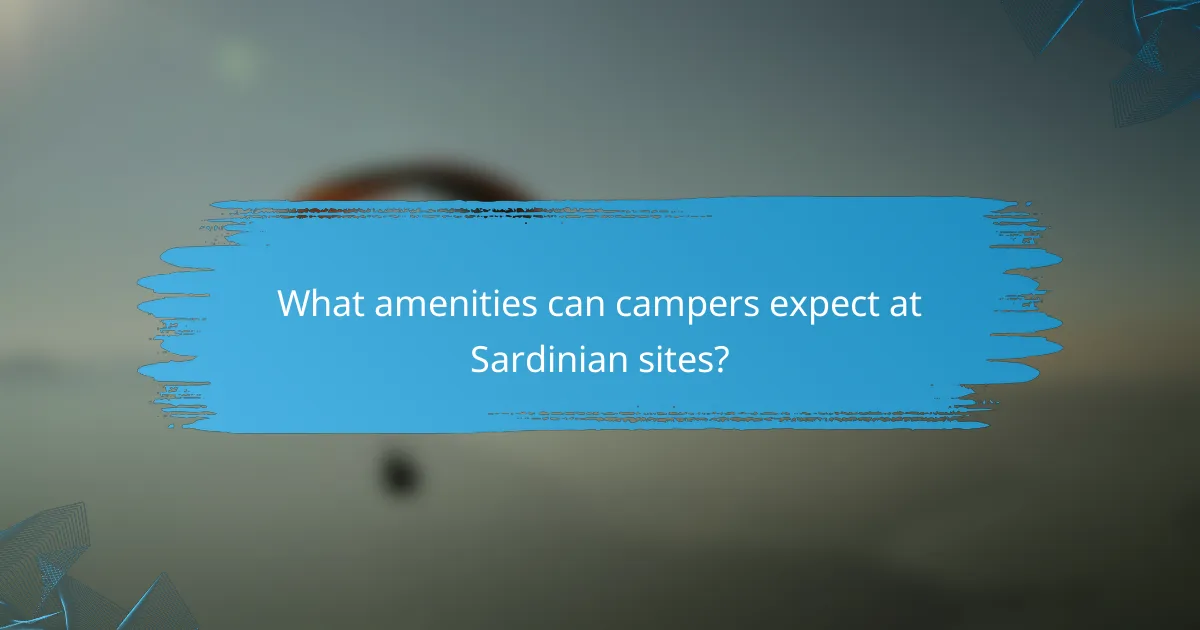
What amenities can campers expect at Sardinian sites?
Campers at Sardinian sites can expect a variety of amenities. Common features include equipped pitches, restrooms, showers, and laundry facilities. Many sites also offer dining options, grocery stores, and recreational activities. Additionally, some campsites provide Wi-Fi access, swimming pools, and organized tours to explore the surrounding natural beauty.
Which facilities are commonly available for campers?
Common facilities for campers in Sardinia include restrooms, showers, cooking areas, and electric hook-ups. Many sites also offer recreational areas, picnic spots, and waste disposal services. Some unique campsites may provide additional amenities like Wi-Fi or guided tours. These facilities enhance the camping experience while ensuring comfort and convenience.
How do amenities vary between public and private sites?
Amenities at public sites are generally more basic compared to private sites, which offer enhanced facilities. Public campgrounds typically provide essential services such as restrooms and picnic tables, while private sites often feature amenities like swimming pools, Wi-Fi, and organized activities. The level of privacy and exclusivity at private sites can also lead to a more comfortable camping experience. As a result, campers may choose based on their desired balance of cost and comfort.
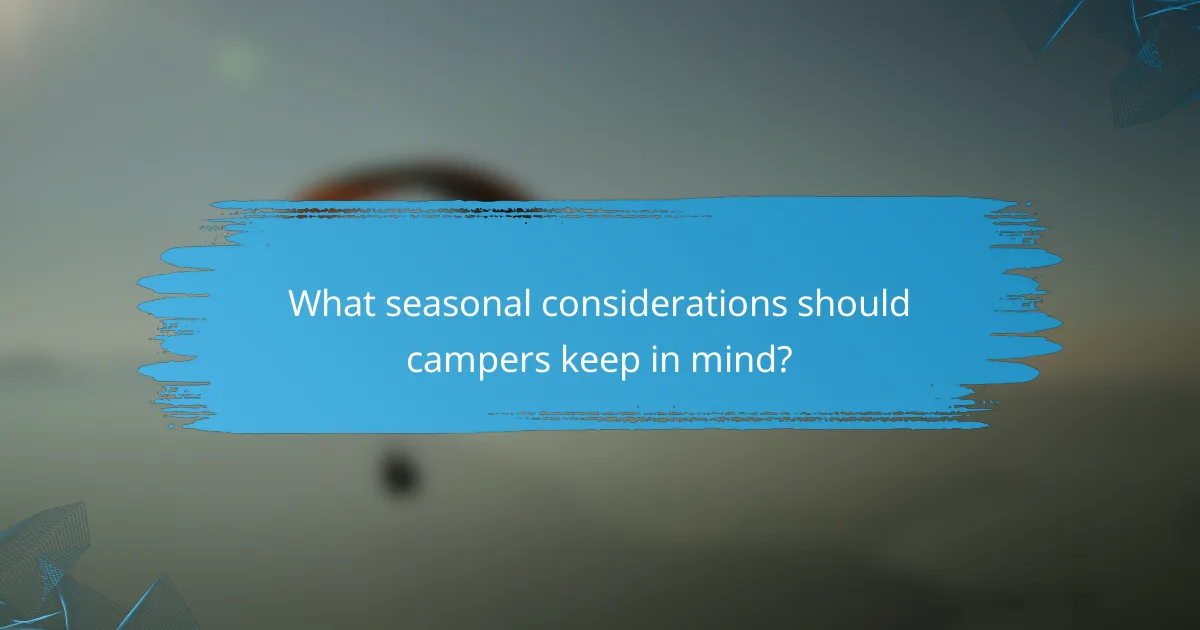
What seasonal considerations should campers keep in mind?
Campers should consider weather conditions, campsite availability, and local wildlife when planning their trips. Sardinia’s summer heat can be intense, making early spring or late fall ideal for comfortable camping. Rainfall varies, so checking forecasts is essential. Additionally, certain regulations may apply during peak seasons to protect the environment.
How does weather impact camping experiences in different seasons?
Weather significantly influences camping experiences in Sardinia across different seasons. In summer, warm temperatures and longer days enhance outdoor activities, while mild winters offer a serene environment for those seeking solitude. Spring brings blooming landscapes, ideal for nature enthusiasts, whereas autumn provides vibrant foliage and cooler weather, perfect for hiking. Each season presents unique opportunities and challenges, shaping the overall camping experience in this picturesque region.
What are the peak times for camping in Sardinia?
The peak times for camping in Sardinia are typically from late spring to early autumn, specifically May to September. During these months, the weather is warm and conducive for outdoor activities. July and August are particularly popular, attracting many visitors due to school holidays. However, early May and late September can offer quieter experiences with pleasant temperatures.
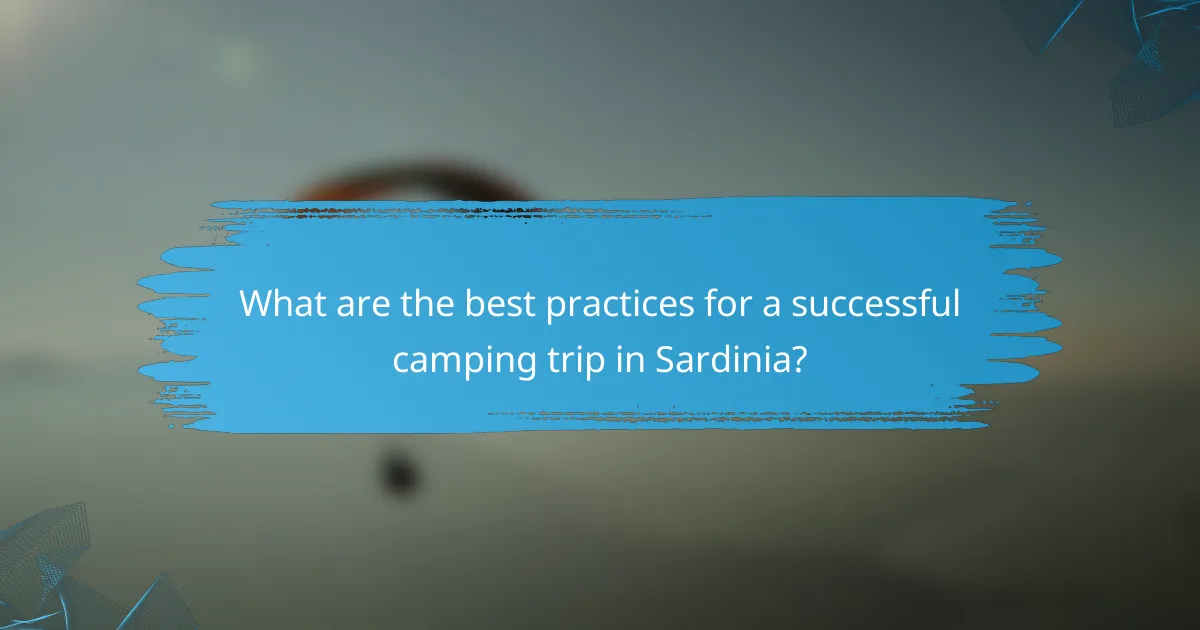
What are the best practices for a successful camping trip in Sardinia?
To ensure a successful camping trip in Sardinia, prioritize research on local sites, regulations, and environmental impact. Choose established campsites to minimize ecological disruption and follow local guidelines to protect natural resources. Prepare for varied weather conditions and pack essential gear, including a reliable tent and cooking equipment. Respect wildlife and maintain cleanliness to preserve the stunning landscapes.
How can campers prepare for local wildlife encounters?
Campers can prepare for local wildlife encounters by understanding the species in the area and adopting safety measures. Research common animals, such as wild boars and foxes, and know their behavior. Store food securely and avoid leaving waste behind to minimize attractants. Use bear-proof containers if necessary and maintain a safe distance from wildlife. Carry bear spray and know how to use it effectively. Educate yourself on local regulations regarding wildlife interactions to ensure a safe camping experience in Sardinia.
What tips can enhance the overall camping experience?
To enhance your camping experience in Sardinia, focus on preparation, local regulations, and environmental awareness. Research the best sites, like beaches and forests, and ensure compliance with local rules to protect nature. Pack essential gear, including eco-friendly products, and respect wildlife. Engage with local communities for cultural insights and sustainable practices.
What common mistakes should campers avoid?
Campers should avoid common mistakes that can diminish their experience in Sardinia. Key errors include neglecting local regulations, failing to respect nature, and not preparing adequately for weather conditions.
1. Ignoring campsite rules can lead to fines or eviction.
2. Leaving waste behind harms the environment and wildlife.
3. Underestimating weather changes may result in discomfort or danger.
4. Overpacking can make hiking cumbersome and limit mobility.
5. Skipping safety gear increases risk during outdoor activities.
6. Not researching local flora and fauna can lead to unsafe encounters.